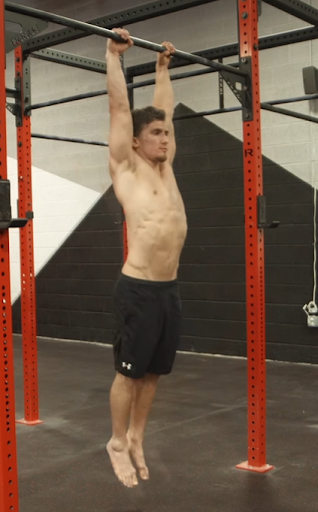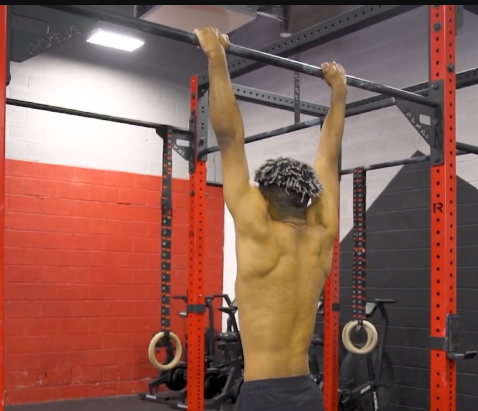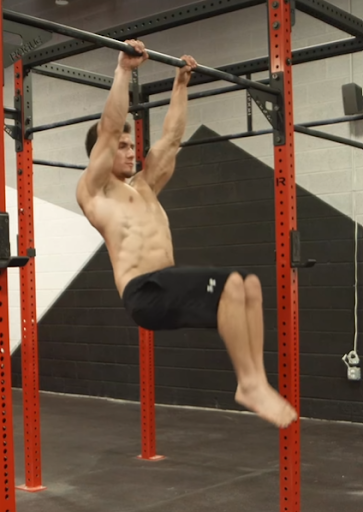Are you ready to unlock a new level of upper-body strength? Today, we’re diving into one of the most underrated exercises that will skyrocket your power, control, and stability—horizontal scapula pulls (Tuck Holds). Now, you might be wondering why this exercise is so important, especially if you’re already working hard on your pull-ups and muscle-ups. Well, think of horizontal scapula pulls as the key to mastering your scapula control. It’s a game-changer for your back and shoulders, setting you up for more significant, more advanced calisthenics moves. Let’s explore why this move should be a staple in your routine!👇
🤯 What Are Horizontal Scapular Pulls?
Horizontal scapula pulls are an often overlooked but highly effective exercise designed to target and strengthen the scapula muscles, also known as the shoulder blades. Unlike traditional pulling movements focusing on large muscle groups like the lats or biceps, horizontal scapula pulls isolate the smaller, stabilizing muscles in the upper back. This exercise builds scapular strength and enhances overall upper-body stability, making it an excellent addition to any workout routine to improve pull-ups, muscle-ups, or shoulder health. Whether a beginner or an advanced athlete, incorporating horizontal scapula pulls helps you develop the muscle coordination needed for more complex movements and reduces the risk of shoulder-related injuries.
🎯 The Benefits of Horizontal Scapula Pulls: Why They Are Essential
Why do you need horizontal scapula pulls? If your upper-body workouts feel lacking or your pull-ups aren’t delivering the results you want, this exercise might be the missing piece. It strengthens key muscles, enhancing control, stability, and overall performance to elevate your training. Here are some of the benefits of adding horizontal scapula pulls to your routine:
1. Scapula Control Mastery
One of the main benefits of horizontal scapula pulls is the mastery of scapula control. This is crucial for advanced movements like muscle-ups and pull-ups. Strengthening these often-overlooked muscles enhances your overall upper-body efficiency and power. The better control you have over your scapula, the more fluid and effective your movements become, elevating your training to the next level.
2. Enhanced Upper-Body Strength
Horizontal scapula pulls specifically target the muscles, crucial in building balanced upper-body strength. Developing these muscles not only makes you stronger but also reduces the risk of injury by ensuring balanced muscle growth and promoting stability in your shoulders.
3. Improved Form & Function
This exercise also helps refine your form in other upper-body exercises. If you’ve struggled with maintaining shoulder health or mobility, horizontal scapula pulls can be the solution. They reinforce proper shoulder alignment, enhancing your form and function across various movements, from pull-ups to push-ups.
4. Posture & Injury Prevention
Another often overlooked benefit is posture improvement. Long hours of sitting can cause rounded shoulders, but the horizontal scapula can help you stand taller and move more aligned by working the smaller stabilizing muscles. They also play a crucial role in injury prevention by ensuring proper scapular stability. Strengthening these muscles protects the shoulder joint, reducing the risk of impingement, rotator cuff injuries, and other common shoulder issues.
5. Efficient Body Mechanics
Lastly, horizontal scapula pulls teach your body to engage the right muscles at the right time. This improves overall body mechanics, allowing you to generate more power in complex movements like muscle-ups and front levers. It also makes everyday tasks more manageable by ensuring you use your muscles more effectively.
💥 How to Perform Horizontal Scapula Pulls: A Step-by-Step Guide
Alright, now that you’re sold on why this exercise is essential, let’s break it down so you can add it to your workout routine today. This move isn’t just about pulling yourself up; it’s about control, precision, and strength.
1. Starting Position
Hang from a bar with an overhand grip. Make sure your arms are fully extended, and engage your core. This is where the magic begins.
2. Scapula Retraction
Here’s the key—retract your shoulder blades as if you’re trying to squeeze a pencil between them. This activates your scapula muscles and sets the foundation for the entire movement.
3. Pulling Motion
Now, begin pulling your body upward to bring your chest to the bar while retracting your scapula. This isn’t about speed—slow and controlled is the way to go. Feel every part of the movement as your upper body starts working hard.
4. Horizontal Hold
Here comes the fun part! Once you’ve pulled yourself up, strive to reach a horizontal position, keeping your body parallel to the ground. This is where your core and back work together to keep you stable.
5. Control the Descent
The descent is just as important as the ascent. Slowly lower yourself back to the starting position while maintaining control. This ensures you’re engaging the muscles throughout the entire movement.
🔥Pro Tips for Mastering Horizontal Scapula Pulls
Mastering the technique is just the start to get the most out of horizontal scapula pulls. A few tweaks and mindful adjustments can make a big difference in your performance and progress.
- Stay Consistent Like any exercise, progress comes with consistency. The more you practice, the more control and strength you’ll build. Challenge yourself by increasing reps or holding the horizontal position longer.
- Focus on Form This move is all about scapula retraction. Keeping your shoulder blades squeezed together ensures you engage the right muscles and build strength.
- Add Variation Once you’re comfortable with the basic movement, start adding variations. Whether it’s longer holds or more advanced positions, mixing it up will keep your body guessing and your muscles growing.
🚫Common Mistakes to Avoid
Now, let’s talk about the traps people tend to fall into when doing horizontal scapula pulls. Avoid these common mistakes to ensure you build strength and not bad habits.
- Neglecting Scapula Retraction It’s easy to forget about your scapula muscles, but trust me—you don’t want to skip this step. Keep those shoulder blades squeezed throughout the entire movement.
- Rushing the Movement This isn’t a race. Slow and steady wins the strength game. Control both the ascent and descent to maximize your muscle engagement.
- Using Momentum Swinging or using momentum might feel like you’re doing more but actually doing less. Keep the movement controlled for authentic, sustainable progress.
🏆Progressions and Variations for All Levels
No matter your skill level, horizontal scapula pulls can be adjusted to match your abilities and help you progress. Let’s explore the best progressions for beginners, intermediate athletes, and advanced practitioners.
Beginner Progressions:
- Assisted Horizontal Scapula Pulls: Start by using resistance bands or placing your feet on the ground to assist with the pulling motion. This decreases the load on your upper body while allowing you to practice scapula control. Focus on perfecting the scapula retraction before adding more resistance.
- Horizontal Scapula Holds: Instead of performing the full range of motion, beginners can work on holding the top position with a retracted scapula for as long as possible. This helps build isometric strength and control in the scapula muscles.
Intermediate Progressions:
- Partial Range of Motion Pulls: Once you’ve mastered the hold and assisted variations, start working on pulling yourself halfway up to the horizontal position and back down. Gradually increase the range of motion as your strength improves.
- Slow Eccentrics: For a more challenging variation, try focusing on the lowering phase of the movement (eccentric). Slowly lower yourself back to the starting position over 5–10 seconds, maintaining control and proper form throughout.
Advanced Progressions:
- Weighted Horizontal Scapula Pulls: Add a weight vest or attach weight plates to your waist to increase resistance. This challenges your scapula and your entire core and upper body.
- Single-Arm Horizontal Scapula Pulls: Once you’ve mastered two arms, take it up a notch by performing the movement with one arm. This demands extreme control and strength, forcing your scapula and core to work overtime to maintain stability.
- Longer Holds and Extended Tucks: Advanced athletes can push the envelope by holding the horizontal position for extended periods or adding additional tucks to increase difficulty.
By following these progressions, you’ll steadily build up the strength and control needed to execute horizontal scapula pulls like a pro.
🤸How Horizontal Scapula Pulls Translate to Other Calisthenics Moves
Horizontal scapula pulls are a gateway to more advanced calisthenics skills by laying the foundation for improved scapular mobility, control, and strength. Let’s break down how mastering this exercise will directly benefit other fundamental calisthenics movements:
- Front Lever:
Front lever exercise demands an immense scapular retraction and core engagement to hold your body horizontally. The scapula control you develop from horizontal scapula pulls is vital for maintaining a lever’s correct form and stability. Without strong scapula retraction, achieving a clean front lever is nearly impossible.
- Muscle-Up:
Many athletes struggle with the transition phase in muscle-ups due to weak scapular control. Horizontal scapula pulls help bridge this gap by teaching you how to control your scapula’s upward and horizontal motion, making the transition smoother and more efficient. This control gives you the power to lift your body over the bar more quickly.
- Planche:
While the planche may seem unrelated, scapula retraction and strength are crucial to mastering it. The ability to control your scapula during horizontal pulls translates to better scapula positioning during the planche, enabling you to maintain the position without collapsing your shoulders forward.
- Handstand Push-Ups:
Scapula stability is essential for balancing your body upside down in this movement. Horizontal scapula pulls strengthen the muscles responsible for keeping your shoulders stable during pressing movements, giving you the stability needed to hold handstands and perform push-ups.
🙌 Integrating Horizontal Scapula Pulls into Your Routine
Knowing when and how to integrate the most horizontal scapula pulls into your workout routine is vital to getting the most out of horizontal scapula pulls. Here’s a guide to help you add them effectively:
- Frequency
Aim to perform horizontal scapula pulls 2–3 times weekly. Since this exercise focuses on strength and control rather than high-volume work, allowing time for recovery is essential to avoid overtraining. Incorporating horizontal scapula pulls at the end of those sessions can be highly effective if you train upper-body pulling movements like pull-ups or rows on separate days.
- Warm-Up or Main Exercise?
Depending on your goals, horizontal scapula pulls can be used in different phases of your workout. Include them in your warm-up routine before moving on to heavier-pulling exercises to improve scapular mobility and stability. For strength building, perform them as a primary exercise alongside your pull-up and rowing variations, focusing on strict form and control.
- Pairing with Other Exercises
Horizontal scapula pulls can be paired with other upper-body pulling exercises for an effective superset. For example, after a set of pull-ups, you can go straight into horizontal scapula pulls to really target the scapula and upper back muscles. This will help improve muscle endurance and control in the long run.
- Use in Deload Weeks
If you’re following a high-intensity workout program, horizontal scapula pulls can be an excellent option for deload weeks. Because they focus more on control and muscle activation than high loads, they allow you to maintain upper-body strength without too much stress on the joints. By strategically integrating horizontal scapula pulls into your routine, you’ll notice faster progress in both strength and control, benefiting all your upper-body exercises.
🧐Frequently Asked Questions:
🔎 What muscles do horizontal pulls work?
Horizontal pulls, like inverted rows and seated cable rows, primarily target the upper back and arm muscles. These include the rhomboids, trapezius, posterior deltoids, and biceps. They help improve posture, enhance shoulder stability, and increase upper body strength.
🔎 Are horizontal pulls better than vertical pulls?
Neither is inherently better. Horizontal pulls focus on the upper back and posture, while vertical pulls, such as pull-ups, target the lats and arm strength. Both exercises complement each other and should be included for balanced upper-body development.
🔎 How often should I include horizontal pulls in my workout?
Incorporating horizontal pulls 2-3 times a week is ideal for building strength and maintaining muscle balance. Pairing them with vertical pulls and other upper-body exercises is important for a well-rounded routine.
🔎 Can horizontal pulls improve posture?
Yes, horizontal pulls are excellent for improving posture. By strengthening the rhomboids and trapezius helps retract the shoulders and reduce the rounded shoulder posture caused by long hours of sitting or poor posture habits.
🔎 Are horizontal pulls good for shoulder stability?
Absolutely. Horizontal pulls work the muscles responsible for shoulder retraction and stability, helping to improve shoulder mobility and reduce the risk of injury during other upper-body movements or sports activities.
Wrap Up
So, are you ready to take your upper-body strength to the next level? With horizontal scapula pulls in your arsenal, you’ll be well on your way to crushing your calisthenics goals. And if you’re looking for even more personalized training, take a free assessment with The Movement Athlete today! Get a custom plan tailored to your fitness level, helping you progress in a way that suits you best. Let’s get moving!




